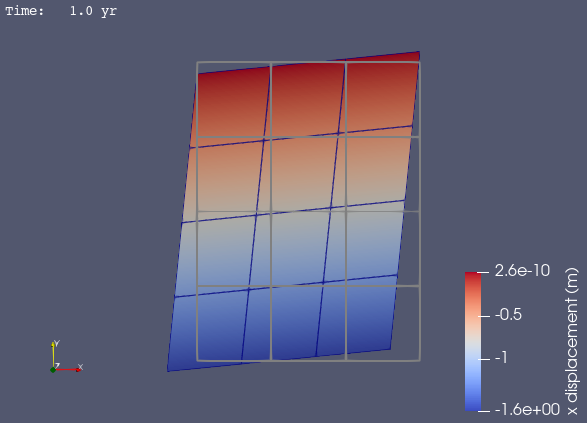Step 3: Shear Displacement and Tractions#
Features
Quadrilateral cells
pylith.meshio.MeshIOAscii
pylith.problems.TimeDependent
pylith.materials.Elasticity
pylith.materials.IsotropicLinearElasticity
spatialdata.spatialdb.UniformDB
pylith.meshio.DataWriterHDF5
Static simulation
LU preconditioner
pylith.bc.DirichletTimeDependent
pylith.bc.NeumannTimeDependent
spatialdata.spatialdb.SimpleDB
Simulation parameters#
In Step 3 we replace the Dirichlet (displacement) boundary conditions on the +y and -y boundaries with equivalent Neumann (traction) boundary conditions.
In order to maintain symmetry and prevent rigid body motion, we constrain both the x and y displacements on the +x and -x boundaries.
The solution matches that in Step 2.
Fig. 30 shows the boundary conditions on the domain.
The parameters specific to this example are in step03_sheardisptract.cfg.
Fig. 30 Boundary conditions for shear deformation. We constrain the x and y displacements on the +x and -x boundaries. We apply tangential (shear) tractions on the +y and -y boundaries.#
The tractions are uniform on each of the two boundaries, so we use a UniformDB.
In PyLith the direction of the tangential tractions in 2D is defined by the cross product of the +z direction and the outward normal on the boundary.
On the +y boundary a positive tangential traction is in the -x direction, and on the -y boundary a positive tangential traction is in the +x direction.
We want tractions in the opposite direction as shown by the arrows in Fig. 30, so we apply negative tangential tractions.
[pylithapp.problem]
bc = [bc_xneg, bc_yneg, bc_xpos, bc_ypos]
bc.bc_xneg = pylith.bc.DirichletTimeDependent
bc.bc_xpos = pylith.bc.DirichletTimeDependent
bc.bc_yneg = pylith.bc.NeumannTimeDependent
bc.bc_ypos = pylith.bc.NeumannTimeDependent
[pylithapp.problem.bc.bc_xneg]
# Degrees of freedom (dof) 0 and 1 correspond to the x and y displacements.
constrained_dof = [0, 1]
label = boundary_xneg
db_auxiliary_field = spatialdata.spatialdb.SimpleDB
db_auxiliary_field.description = Dirichlet BC -x boundary
db_auxiliary_field.iohandler.filename = sheardisp_bc_xneg.spatialdb
db_auxiliary_field.query_type = linear
[pylithapp.problem.bc.bc_yneg]
label = boundary_yneg
db_auxiliary_field = spatialdata.spatialdb.UniformDB
db_auxiliary_field.description = Neumann BC -y boundary
db_auxiliary_field.values = [initial_amplitude_tangential, initial_amplitude_normal]
db_auxiliary_field.data = [-4.5*MPa, 0*MPa]
Running the simulation#
$ pylith step03_sheardisptract.cfg
# The output should look something like the following.
>> /software/unix/py39-venv/pylith-debug/lib/python3.9/site-packages/pylith/meshio/MeshIOObj.py:44:read
-- meshioascii(info)
-- Reading finite-element mesh
>> /src/cig/pylith/libsrc/pylith/meshio/MeshIO.cc:94:void pylith::meshio::MeshIO::read(topology::Mesh *)
-- meshioascii(info)
-- Component 'reader': Domain bounding box:
(-6000, 6000)
(-16000, -0)
# -- many lines omitted --
>> /software/unix/py39-venv/pylith-debug/lib/python3.9/site-packages/pylith/problems/TimeDependent.py:139:run
-- timedependent(info)
-- Solving problem.
0 TS dt 0.01 time 0.
0 SNES Function norm 6.059797141590e-03
Linear solve converged due to CONVERGED_ATOL iterations 1
1 SNES Function norm 2.140441363908e-18
Nonlinear solve converged due to CONVERGED_FNORM_ABS iterations 1
1 TS dt 0.01 time 0.01
>> /software/unix/py39-venv/pylith-debug/lib/python3.9/site-packages/pylith/problems/Problem.py:201:finalize
-- timedependent(info)
-- Finalizing problem.
As expected, the output written to the terminal is nearly identical to what we saw for Steps 1 and 2.
Visualizing the results#
In Fig. 31 we use ParaView to visualize the x displacement field using the viz/plot_dispwarp.py Python script.
As in Step 2 we override the default name of the simulation file with the name of the current simulation before running the viz/plot_dispwarp.py Python script.
>>> SIM = "step03_sheardisptract"

Fig. 31 Solution for Step 3. The colors of the shaded surface indicate the magnitude of the x displacement, and the deformation is exaggerated by a factor of 1000. The undeformed configuration is show by the gray wireframe. The solution matches the one from Step 2.#
